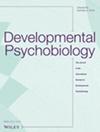Psychometric Properties of the Neural Response to Rewards and Errors Across Mid- to Late-Adolescence
Abstract
Event-related potential (ERP) measures of reward- and error-related brain activity have been used to elucidate neural mechanisms contributing to the development of psychopathology. Adolescence is a critical developmental period that is associated with changes in ERP reward- and error-related brain activity. However, there is a paucity of within-subject research examining whether the reliability of ERP measures is the same or changes across adolescence. Moreover, it is unclear whether the time-frequency representation of reward- and error-related brain activity demonstrates similar psychometric properties. The present study examined the psychometric properties of reward- and error-related brain activity in five hundred and fifty 13.5- to 15.5-year-old (M = 14.4, SD = 0.63) girls. Participants completed the doors and flanker tasks while electroencephalography (EEG) was recorded at two assessments: baseline and 3 years later. Reward- and error-related brain activity were quantified using the time-domain reward positivity (RewP) and error-related negativity (ERN), respectively, as well as time-frequency delta and theta activity. Results indicated that all measures demonstrated adequate split-half reliability at each assessment and 3-year test–retest reliability across assessments. The present study indicates that the psychometric properties of time-domain and time-frequency reward- and error-related brain activity are largely consistent across adolescence, supporting their potential use as individual differences measures of risk for psychopathology.

 求助内容:
求助内容: 应助结果提醒方式:
应助结果提醒方式:


